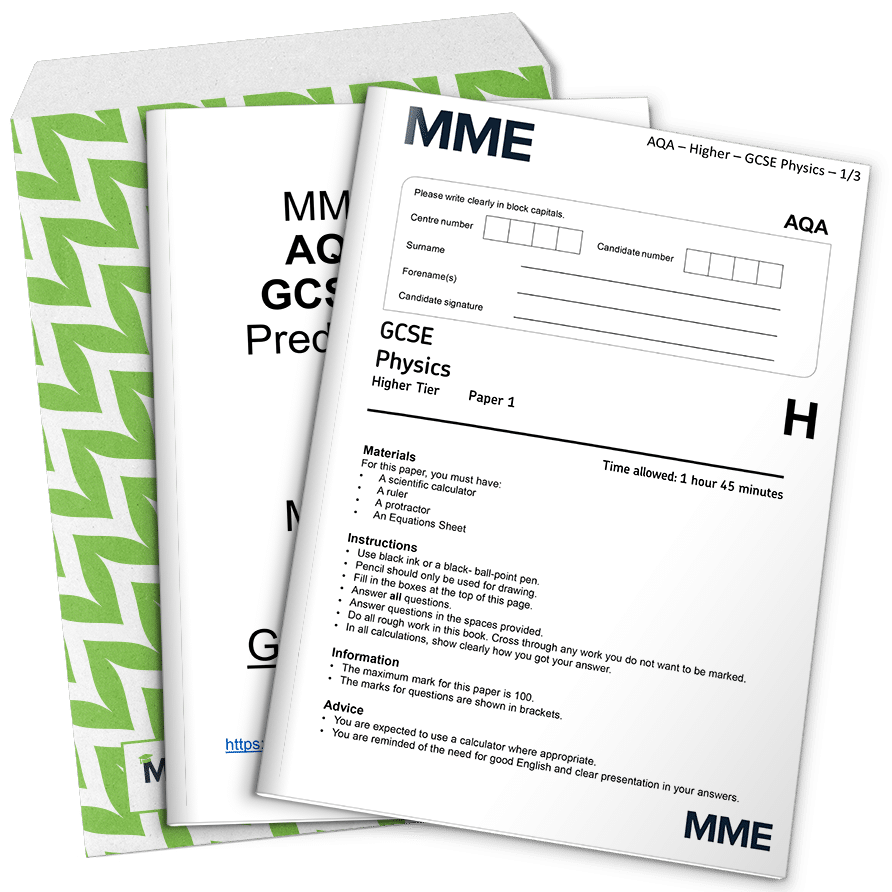AQA GCSE Physics: The Basics
Currently, the AQA GCSE exams (Assessment and Qualifications Alliance, General Certificate of Secondary Education) must be taken in person at an accredited examination centre. This is to maintain the integrity and standardised administration of the exam.
There aren’t any official online options for taking the GCSE exams.
Exam Structure
Two Written Papers
- Paper 1: Covers specific topics in Physics. Duration: 1 hour 45 minutes.
Energy
Electricity
Particle model of matter
Atomic structure
- Paper 2: Covers additional topics. Duration: 1 hour 45 minutes.
Forces
Waves
Magnetism and electromagnetism
Space physics (only in the Physics course, not in Combined Science)
Key Requirements
- Understanding Core Concepts: Make sure you thoroughly grasp the basic principles of each topic.
- Mathematical Skills: Be comfortable with calculations, units, and using equations. Practising these regularly can make a huge difference.
- Practical Knowledge: Be familiar with common experiments, how they’re set up, and what they demonstrate.
- Application of Knowledge: Learn to apply your understanding to solve problems, both theoretical and practical.
Importance of Past Papers
AQA GCSE Physics past papers are essential for preparation. They help you familiarise yourself with the format, question types, and the marking style. They provide a simulation of the actual exam experience, helping you manage time and stress.
Format of the Exam Papers with Examples
Multiple Choice
Multiple Choice Questions (MCQs): Quick, focused questions that test your grasp of fundamental concepts.
Strategy: These are usually quick wins. Scan through and answer the ones you’re confident about first.
Benefit: Builds early momentum and secures some easy marks.
Which of the following describes an endothermic reaction?
a) Releases heat
b) Absorbs heat
c) Produces light
d) Creates sound
Answer: b) Absorbs heat
Explanation: An endothermic reaction is characterised by the absorption of heat from its surroundings, resulting in a decrease in temperature around the reaction site.
Short Answer
Short Answer Questions: Requires concise answers to direct questions.
Strategy: Read the question carefully and address exactly what’s being asked. Keep it concise but complete.
Benefit: Saves time, and these typically test straightforward facts or definitions.
What is the unit of electric current?
Answer: The unit of electric current is the ampere (A).
Explanation: The ampere, often shortened to “amp,” is the standard unit of electric current in the International System of Units (SI).
Calculation
Calculations: Problems where you need to apply formulas and show your working.
Strategy: Write down the formula, substitute the values, and show your working out. If you’re unsure, move on and return later.
Benefit: Clear working out can earn partial marks even if the final answer is off.
A car accelerates from 0 to 60 m/s in 5 seconds. Calculate the acceleration.
Answer:
Step 1: Write down the formula for acceleration: (а = ΔV/Δt )
Step 2: Substitute the given values: ( a = (60 m/s – 0 m/s)/5 s)
Step 3: Calculate: (а = 60/5 = 12 , m/s²)
Explanation: The acceleration of the car is 12 metres per second squared (m/s²), calculated by dividing the change in velocity (60 m/s) by the time taken (5 s).
Practical-Based
Practical-based Questions: Involves interpreting data or describing experiments you’ve studied or performed.
Strategy: Relate the question to practical experiments you’ve performed or studied. Visualise the setup and procedure.
Benefit: Links theory to hands-on experience, which can make these questions easier to approach.
Describe the method to determine the density of an irregular object.
Answer:
Step 1: Measure the mass of the object using a balance.
Step 2: Submerge the object in a graduated cylinder partially filled with water and note the volume displacement.
Step 3: Calculate density using the formula ( d = M/V), where (d) is density, (m) is mass, and (V) is volume displaced.
Explanation: Density is defined as mass per unit volume. By measuring the mass and the volume displacement caused by the object, you can calculate its density.
Extended Response
Extended Response Questions: These might require detailed explanations or descriptions, often linking multiple ideas.
Strategy: Spend a little more time planning your response. Create a brief outline if needed before writing. Ensure you cover all parts of the question.
Benefit: Allows you to structure your answer logically, covering multiple aspects in a coherent flow.
Explain how the wave model of light can account for the phenomenon of diffraction.
Answer:
Step 1: Define diffraction – the bending of light waves around the edges of an obstacle or aperture.
Step 2: Discuss the wave model – light behaves as a wave with crests and troughs.
Step 3: Explain how when light waves encounter an obstacle or slit, they spread out and interfere constructively and destructively.
Conclusion: The wave model accounts for diffraction as the wavefronts bend and spread when they meet edges, creating patterns of light and dark fringes due to interference.
Explanation: The extended response succinctly ties the wave nature of light to the observable phenomenon of diffraction, covering how wavefronts interact with obstacles and produce interference patterns.
Mark Schemes and Grading
These are detailed guides used by examiners to determine how many marks to award for each question. They outline expected answers and acceptable variations. They include point-by-point breakdowns for what constitutes full marks, partial credit, or no marks at all.
Trained examiners manually grade the papers. They follow the mark schemes closely, ensuring consistency across all candidates. After grading, examiners provide standardised feedback. Detailed reports or breakdowns of performance are typically shared by schools or exam centres.
- Data Aggregation: While human examiners grade the papers, computers often handle the aggregation of scores and generation of final results. This helps ensure accuracy and timeliness.
Exam Tips
- Prioritise Easier Questions
Start with MCQs and short answer questions to rack up quick points.
Save more time-consuming calculations and extended responses for last.
- Practice Regularly
Regularly work through past papers under timed conditions to get familiar with the exam pace.
- Mind Maps and Flashcards
Utilise mind maps for overarching concepts and flashcards for quick recall facts and formulas.
- Group Study Sessions
Discuss and explain concepts with peers; teaching others is a powerful way to consolidate your own understanding.
Useful Advice for Prep
- Practise Past Papers: Get your hands on as many past papers and mark schemes as you can. They’re the best way to get a feel for the types of questions asked and the preferred answering style.
- Focus on Practical Skills: Pay attention during practical lessons and review past practical questions. Being able to describe experimental setups and analyse results is crucial.
- Equation Familiarity: Memorise key equations and understand how to manipulate them based on what is given and what is required.
- Revision Guides and Flashcards: Use revision guides and make flashcards for important concepts, formulas, and experiments. They’re great for quick reviews.
- Time Management: Practice under timed conditions to get used to the pace of the exam. Allocate time per section to avoid last-minute rushes.
Common Mistakes and Pitfalls
During Preparation
- Neglecting Practical Skills
Ensure you understand the practical experiments. Many students overlook this and focus solely on theory.
- Ignoring Mark Schemes
Study the mark schemes alongside past papers to understand what examiners are specifically looking for in answers.
- Cramming Equations
Memorise the key equations and understand how to apply them. Don’t just rely on rote memorization; understand their uses and limitations.
During the Exam
- Misinterpreting Questions
Read each question carefully. Take a moment to ensure you understand what’s being asked before diving into your answer.
- Skipping Steps in Calculations
Show all your workings. Even if you make a mistake along the way, you can still earn partial marks for correct methodology.
- Running Out of Time
Manage your time effectively. Complete the questions you find easiest first to secure those marks, then tackle the harder ones.
- Inadequate Planning for Extended Responses:
Spend a few minutes planning your extended response questions. A properly structured answer can make a big difference.
- Not Reviewing Answers
If time allows, review your answers. Check for obvious mistakes or questions you might have missed.
By keeping these strategies and common pitfalls in mind, you’ll give yourself the best possible chance of acing your AQA GCSE Physics exam. Picture yourself confidently navigating through the exam, equipped with all the knowledge and skills we’ve discussed.
Remember, the key is to stay organised, practice routinely, and approach each type of question with a tailored strategy.
Keep your revision sessions varied and active. Mix up reading with problem-solving and hands-on experiments. Discuss tricky concepts with your brother or study buddies—teaching each other can really solidify your understanding.




